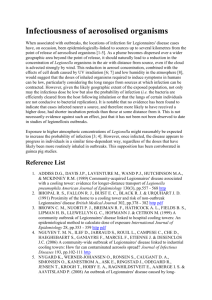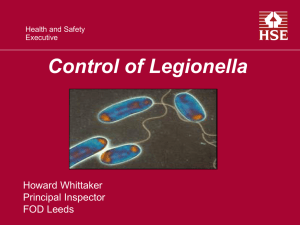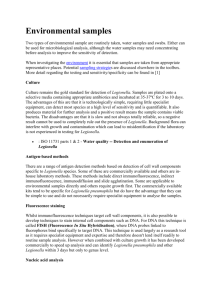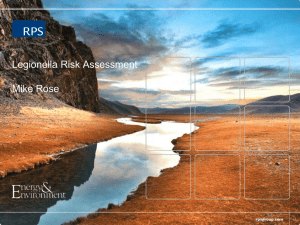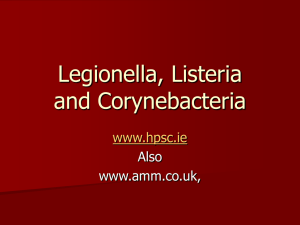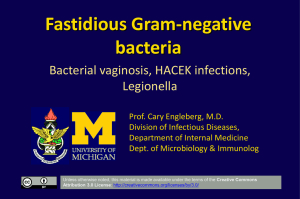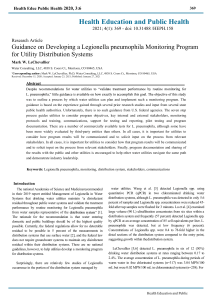Immune response to a Legionella infection
advertisement
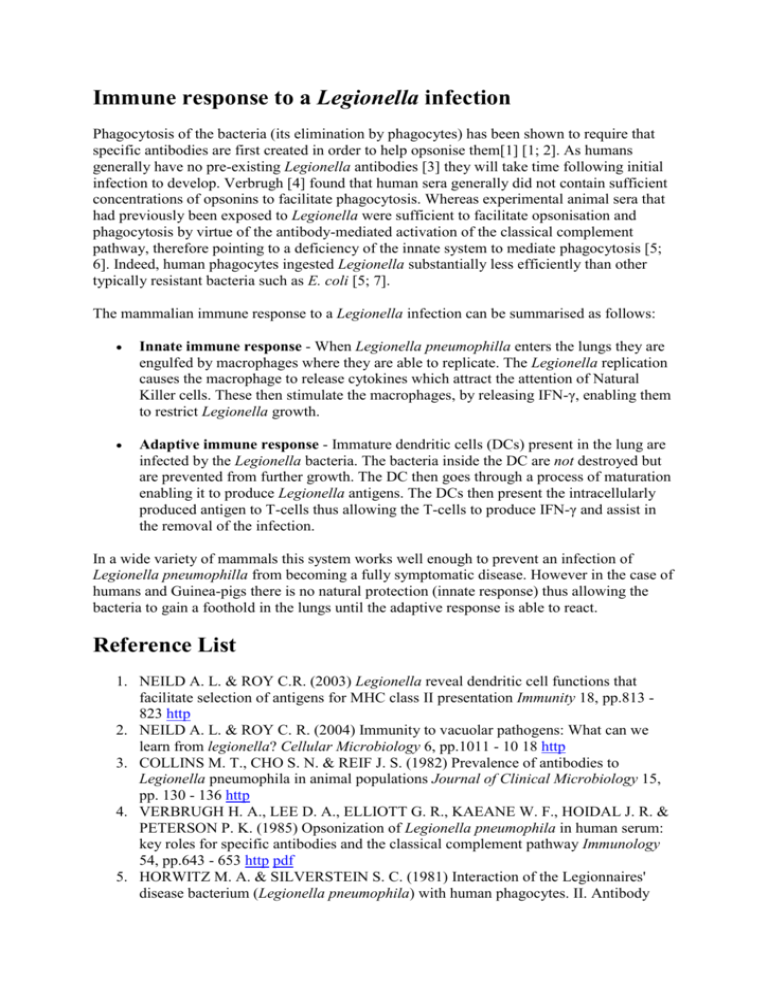
Immune response to a Legionella infection Phagocytosis of the bacteria (its elimination by phagocytes) has been shown to require that specific antibodies are first created in order to help opsonise them[1] [1; 2]. As humans generally have no pre-existing Legionella antibodies [3] they will take time following initial infection to develop. Verbrugh [4] found that human sera generally did not contain sufficient concentrations of opsonins to facilitate phagocytosis. Whereas experimental animal sera that had previously been exposed to Legionella were sufficient to facilitate opsonisation and phagocytosis by virtue of the antibody-mediated activation of the classical complement pathway, therefore pointing to a deficiency of the innate system to mediate phagocytosis [5; 6]. Indeed, human phagocytes ingested Legionella substantially less efficiently than other typically resistant bacteria such as E. coli [5; 7]. The mammalian immune response to a Legionella infection can be summarised as follows: Innate immune response - When Legionella pneumophilla enters the lungs they are engulfed by macrophages where they are able to replicate. The Legionella replication causes the macrophage to release cytokines which attract the attention of Natural Killer cells. These then stimulate the macrophages, by releasing IFN-γ, enabling them to restrict Legionella growth. Adaptive immune response - Immature dendritic cells (DCs) present in the lung are infected by the Legionella bacteria. The bacteria inside the DC are not destroyed but are prevented from further growth. The DC then goes through a process of maturation enabling it to produce Legionella antigens. The DCs then present the intracellularly produced antigen to T-cells thus allowing the T-cells to produce IFN-γ and assist in the removal of the infection. In a wide variety of mammals this system works well enough to prevent an infection of Legionella pneumophilla from becoming a fully symptomatic disease. However in the case of humans and Guinea-pigs there is no natural protection (innate response) thus allowing the bacteria to gain a foothold in the lungs until the adaptive response is able to react. Reference List 1. NEILD A. L. & ROY C.R. (2003) Legionella reveal dendritic cell functions that facilitate selection of antigens for MHC class II presentation Immunity 18, pp.813 823 http 2. NEILD A. L. & ROY C. R. (2004) Immunity to vacuolar pathogens: What can we learn from legionella? Cellular Microbiology 6, pp.1011 - 10 18 http 3. COLLINS M. T., CHO S. N. & REIF J. S. (1982) Prevalence of antibodies to Legionella pneumophila in animal populations Journal of Clinical Microbiology 15, pp. 130 - 136 http 4. VERBRUGH H. A., LEE D. A., ELLIOTT G. R., KAEANE W. F., HOIDAL J. R. & PETERSON P. K. (1985) Opsonization of Legionella pneumophila in human serum: key roles for specific antibodies and the classical complement pathway Immunology 54, pp.643 - 653 http pdf 5. HORWITZ M. A. & SILVERSTEIN S. C. (1981) Interaction of the Legionnaires' disease bacterium (Legionella pneumophila) with human phagocytes. II. Antibody promotes binding of L. pneumophila to monocytes but does not inhibit intracellular multiplication. Journal of Experimental Medicine 153, pp.386 - 397 http pdf 6. WEERATNA R., STAMLER D. A., EDELSTEIN P. H., RIPLEY M., MARRIE T., HOSKIN D. & HOFFMAN P. S. (1994) Human and guinea pig immune responses to Legionella pneumophila protein antigens OmpS and Hsp60. Infection and Immunity 62, pp.3454 - 3462 http pdf 7. NASH T. W., LIBBY D. M. & HORWITZ M. A. (1984) Interaction between the Legionnaires' disease bacterium (Legionella pneumophila) and human alveolar macrophages. Influence of antibody, lymphokines, and hydrocortisone. Journal of Clinical Investigation 74, pp.771 - 782 http pdf [1] Legionella bacteria are naturally resistant to phagocytes, and so need to be put through what is called an opsonisation process to make them more susceptible to phagocytosis.




